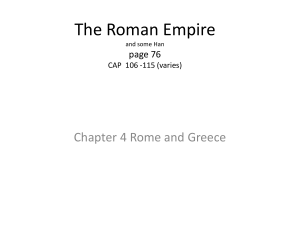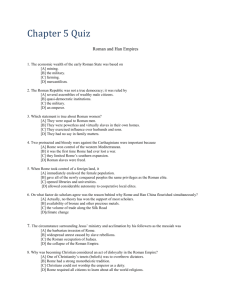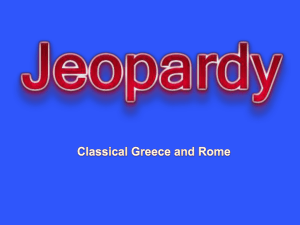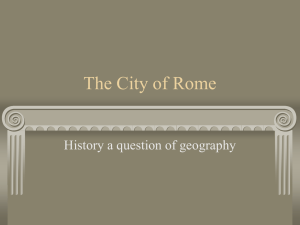Chapter 5 Notes Outline
advertisement
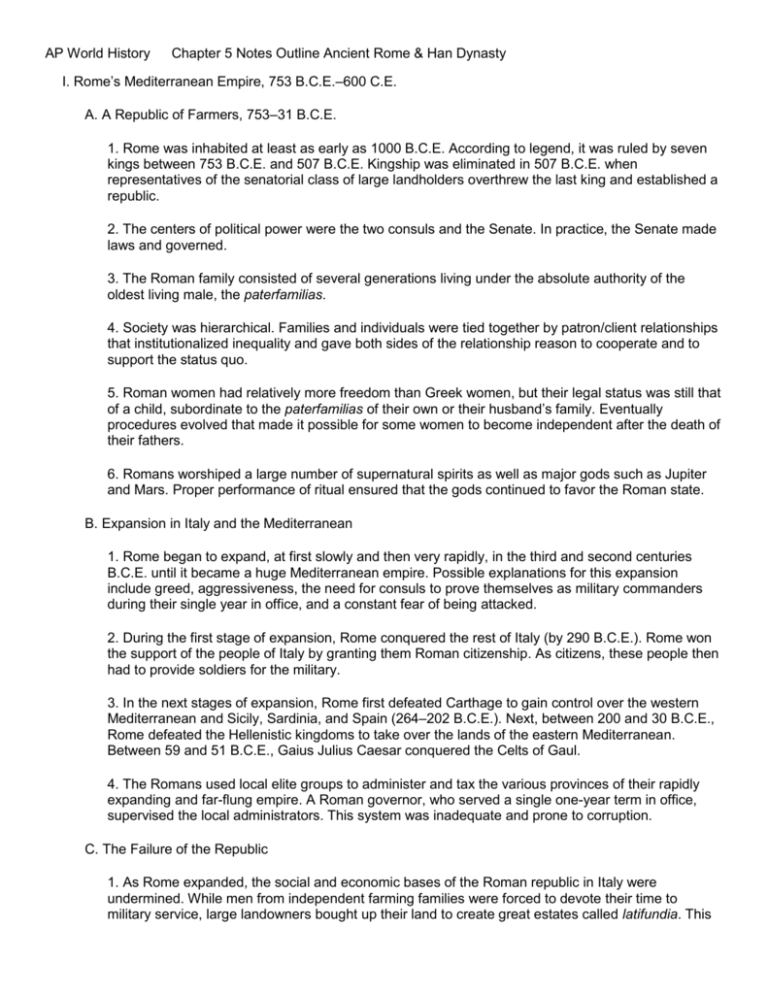
AP World History Chapter 5 Notes Outline Ancient Rome & Han Dynasty I. Rome’s Mediterranean Empire, 753 B.C.E.–600 C.E. A. A Republic of Farmers, 753–31 B.C.E. 1. Rome was inhabited at least as early as 1000 B.C.E. According to legend, it was ruled by seven kings between 753 B.C.E. and 507 B.C.E. Kingship was eliminated in 507 B.C.E. when representatives of the senatorial class of large landholders overthrew the last king and established a republic. 2. The centers of political power were the two consuls and the Senate. In practice, the Senate made laws and governed. 3. The Roman family consisted of several generations living under the absolute authority of the oldest living male, the paterfamilias. 4. Society was hierarchical. Families and individuals were tied together by patron/client relationships that institutionalized inequality and gave both sides of the relationship reason to cooperate and to support the status quo. 5. Roman women had relatively more freedom than Greek women, but their legal status was still that of a child, subordinate to the paterfamilias of their own or their husband’s family. Eventually procedures evolved that made it possible for some women to become independent after the death of their fathers. 6. Romans worshiped a large number of supernatural spirits as well as major gods such as Jupiter and Mars. Proper performance of ritual ensured that the gods continued to favor the Roman state. B. Expansion in Italy and the Mediterranean 1. Rome began to expand, at first slowly and then very rapidly, in the third and second centuries B.C.E. until it became a huge Mediterranean empire. Possible explanations for this expansion include greed, aggressiveness, the need for consuls to prove themselves as military commanders during their single year in office, and a constant fear of being attacked. 2. During the first stage of expansion, Rome conquered the rest of Italy (by 290 B.C.E.). Rome won the support of the people of Italy by granting them Roman citizenship. As citizens, these people then had to provide soldiers for the military. 3. In the next stages of expansion, Rome first defeated Carthage to gain control over the western Mediterranean and Sicily, Sardinia, and Spain (264–202 B.C.E.). Next, between 200 and 30 B.C.E., Rome defeated the Hellenistic kingdoms to take over the lands of the eastern Mediterranean. Between 59 and 51 B.C.E., Gaius Julius Caesar conquered the Celts of Gaul. 4. The Romans used local elite groups to administer and tax the various provinces of their rapidly expanding and far-flung empire. A Roman governor, who served a single one-year term in office, supervised the local administrators. This system was inadequate and prone to corruption. C. The Failure of the Republic 1. As Rome expanded, the social and economic bases of the Roman republic in Italy were undermined. While men from independent farming families were forced to devote their time to military service, large landowners bought up their land to create great estates called latifundia. This AP World History Chapter 5 Notes Outline Ancient Rome & Han Dynasty meant both a decline in Rome’s source of soldiers and a decline in food production because latifundia owners preferred to grow cash crops like grapes rather than staple crops such as wheat. 2. Because slave labor was cheap in an expanding empire, Italian peasants, driven off the land and not employed by the latifundia, drifted into the cities where they formed a fractious unemployed underclass. 3. As the independent farming family that had been the traditional source of soldiers disappeared, Roman commanders built their armies from men from the underclass who tended to give their loyalty, not to the Roman state, but to their commander. This led to generals taking control of politics, to civil wars, and finally to the end of the republican system of government. D. The Roman Principate, 31 B.C.E.–330 C.E. 1. Julius Caesar’s grandnephew Octavian (also known as Augustus) took power in 31 B.C.E., reorganized the Roman government, and ruled as a military dictator. 2. During the reign of Augustus, Egypt, parts of the Middle East, and Central Europe were added to the empire. He created a paid civil service from a class of wealthy merchants and landowners to manage the growing empire. 3. After Augustus died, several members of his family succeeded him. However, the position of emperor was not necessarily hereditary; in the end, armies chose emperors. 4. Rather than laws developing through a senate and assemblies, as it had during the Republic, the emperor became a major source of laws during the Principate. The development of Roman law culminated in the sixth century C.E. and became the foundation of European law. E. An Urban Empire 1. About 80 percent of the 50 to 60 million people of the Roman Empire were rural farmers, but the empire was administered through and for a network of cities and towns. In this sense, it was an urban empire. Rome had about a million residents, other large cities (Alexandria, Antioch, and Carthage) had several hundred thousand each, while many Roman towns had populations of several thousand. 2. In Rome, the upper classes lived in elegant, well-built, well-appointed houses; many aristocrats also owned country villas. The poor lived in dark, dank, fire-prone wooden tenements in squalid slums built in the low-lying parts of the city. 3. Provincial towns imitated Rome both in urban planning and in urban administration. The local elite, who served the interests of Rome, dominated town councils. The local elite also served their communities by using their wealth to construct amenities such as aqueducts, baths, theatres, gardens, temples, and other public works and entertainment projects. 4. Rural life in the Roman Empire involved lots of hard work and very little entertainment. Rural people had little contact with representatives of the government. By the early centuries C.E., absentee landlords who lived in the cities owned most rural land, while the land was worked by tenant farmers supervised by hired foremen. 5. Manufacture and trade flourished under the pax romana. Grain had to be imported to feed the huge city of Rome. Rome and the Italian towns (and later, provincial centers) exported glass, AP World History Chapter 5 Notes Outline Ancient Rome & Han Dynasty metalwork, pottery, and other manufactures to the provinces. Romans also imported Chinese silk and Indian and Arabian spices. 6. One of the effects of the Roman Empire was Romanization. In the western part of the Empire, the Latin language, Roman clothing, and the Roman lifestyle were adopted by local people; and indigenous cultures had an effect on Rome through cultural interaction. As time passed, Roman emperors gradually extended Roman citizenship to all free male adult inhabitants of the empire. F. The Rise of Christianity 1. Jesus lived in a society marked by resentment against Roman rule, which had inspired the belief that a Messiah would arise to liberate the Jews. When Jesus sought to reform Jewish religious practices, the Jewish authorities in Jerusalem turned him over to the Roman governor for execution. 2. After the execution, Jesus’ disciples continued to spread his teachings; they also spread their belief that Jesus had been resurrected. At this point, the target of their proselytizing was their fellow Jews. 3. The target of proselytizing changed from Jews to non-Jews in the 40s–70s C.E. First, Paul of Tarsus, an Anatolian Jew, discovered that non-Jews (gentiles) were much more receptive to the teachings of Jesus than Jews were. Second, a Jewish revolt in Judaea (66 C.E.) and the subsequent Roman reconquest destroyed the original Jewish Christian community in Jerusalem. 4. Christianity grew slowly for two centuries, developing a hierarchy of priests and bishops, hammering out a commonly accepted theological doctrine, and resisting the persecution of Roman officials. By the late third century, Christians were a sizeable minority in the Roman Empire. 5. The expansion of Christianity in the Roman Empire came at a time when Romans were increasingly dissatisfied with their traditional religion. This dissatisfaction inspired Romans to become interested in a variety of mystery cults and universal creeds that had their origins in the eastern Mediterranean. G. Byzantines and Germans 1. While Roman rule and the traditions of Rome died in the west, they were preserved in the Byzantine Empire and in its capital, Constantinople. 2. The popes in Rome were independent of secular power, but the Byzantine emperor was appointed the patriarch of Constantinople and intervened in doctrinal disputes. Religious differences and doctrinal disputes permeated the Byzantine Empire; nonetheless, polytheism was quickly eliminated. 3. While the unity of political and religious power prevented the Byzantine Empire from breaking up, the Byzantines did face serious foreign threats. The Goths and Huns on the northern frontier were not difficult to deal with, but on the east, the Sasanids harassed the Byzantine Empire for almost three hundred years. II. The Origins of Imperial China, 221 B. C. E.–220 C. E. A. Resources and Populations B. Hierarchy, Obedience, and Belief AP World History Chapter 5 Notes Outline Ancient Rome & Han Dynasty 1. The family was the basic unit of society. The family was conceived as an unbroken chain of generations, including ancestors as well as current generations. Ancestors were thought to take an active interest in the affairs of the current generation, and they were routinely consulted, appeased, and venerated. 2. Chinese society believed that a hierarchy in the family, dominated by the elder male, reflected a hierarchy in society, dominated by rulers, with interdependent relationships more important than the individual. The status and authority of women depended upon their social status. Women of the royal family could have some political influence. A young wife was expected to be obedient and recognize her mother-in-law’s authority over her. All women were expected to be obedient, but their quality of life depended upon economic circumstances. C. The First Chinese Empire, 221–207 B.C.E. 1. By 221 B.C.E., the state of Qin had unified all of northern and central China into the first Chinese “empire.” Success for the Qin came from long experience in defending against “barbarian” neighbors, the adoption of severe Legalist methods, and the ambition of the ruthless young king Shi Huangdi and his advisors. 2. Upon uniting China, the Qin established a strong centralized state by eliminating rival centers of authority, establishing primogeniture, and creating a strong bureaucracy. It standardized law, measurements, coinage, and writing. Following the advice of his prime minister, Li Si, Shi Huangdi followed the Legalist view and suppressed Confucianism. 3. To secure the empire’s borders from northern raiders, the Qin sent a large military force to drive the nomads north. To ensure they would not lose the newly gained territory, they constructed connections and extensions to walls built earlier to defend the kingdoms, the ancestor of the Great Wall of China. Shi Huangdi’s attack on the nomads inadvertently united the fragmented nomads under the Xiongnu Confederacy, a source of threat to China for centuries to come. 4. To fill their military and labor needs, the Qin government instituted an oppressive program of compulsory military and labor services. 5. Shi Huangdi died in 210 B.C.E. and was buried in a monumental tomb guarded by a terracotta clay army of seven thousand soldiers. His son secured the throne but proved to be a weak leader who could not withstand the uprisings that broke out from the resentment of different groups. Qin rule was over by 206 B.C.E. D. The Long Reign of the Han, 206 B.C.E.–220 C.E. 1. Gaozu (the throne name of Liu Bang) was a peasant who defeated all other contestants for control of China, establishing the Han dynasty. The Han established a political system that drew on both Confucian philosophy and Legalist techniques. 2. Han rulers faced challenges at first from residual resentments of the ruthless rule of the Qin. To ease their transition and help the economy, the Qin reduced taxes and government spending, and collected and stored surplus grain for times of shortage. For those who had aided him, Gaozu restored the system of feudal grants abolished by the Qin. 3. Confrontation with the Xiongnu confederacy nomads of the north revealed the inadequacy of Han troops, leading Gaozu to develop a policy of appeasement, buying them off with annual gifts. AP World History Chapter 5 Notes Outline Ancient Rome & Han Dynasty 4. The Han went through a period of territorial expansion under Emperor Wu (r. 141–87 B.C.E.) who increased the power of the emperor. During his rule, he expanded the empire into areas as far as northern Vietnam, Manchuria, and North Korea. Instead of appeasing the Xiongnu, he built his military to fight the northern nomads. 5. Wu’s reign saw the expansion of Chinese territory into the northwest and the foundations of the Silk Road, which would later affect the economic health of Asia. To pay for the military buildup, government monopolies on high-profit commodities added to the treasury, though not without controversy. The state also adopted Confucianism, using Confucian scholars as officials of the government, who in turn expected exemplary ethical behavior from their rulers. E. Technology and Trade F. Decline of the Han Empire 1. An ambitious high official seized power from 9 to 23 C.E. but was killed in his palace, and a member of the Han royal family was again installed as emperor. At this time the capital was moved east to Luoyang. 2. The Han Empire was undermined by a number of factors. First, the imperial court was plagued by weak leadership and court intrigue. Second, nobles and merchants built up large landholdings at the expense of the small farmers, and peasants sought tax relief, reducing revenues for the empire. Third, the system of military conscription broke down and the central government had to rely on mercenaries whose loyalty was questionable. 3. These factors, compounded by factionalism at court, official corruption, peasant uprisings, and nomadic attacks, led to the fall of the dynasty in 220 C.E. China entered a period of political fragmentation that lasted until the late sixth century. III. Conclusion A. Similarities 1. The Han and Roman Empires were similar relative to agriculture being their fundamental economic activity. Both empires received revenue from a percentage of the annual harvests. And both empires strengthened their central rule by breaking the power of old aristocratic families, reducing their land holdings. Both empires saw their authority eroding at the end of their reigns by the reversal of this process. 2. Both empires spread out from an ethnically homogeneous core to encompass widespread territories of diverse cultures. Many in the conquered lands adopted the cultural elements of the core, and the core also adopted some of the cultural traditions of their far-flung regions. The extent of their empires forced both empires to create a well-trained bureaucracy and to make use of local officials to administer their interests. 3. Both empires built roads to facilitate military movement that later became routes to spread commerce and culture. While the majority of populations in both empires lived in the countryside, those living in urban centers enjoyed the more cosmopolitan advantages of empire. 4. Both empires faced common problems in terms of defense and found their domestic economies undermined by their military expenditures. AP World History Chapter 5 Notes Outline Ancient Rome & Han Dynasty 5. Both empires were overrun by new peoples who had been so deeply influenced by the imperial cultures of Rome and of China that they maintained some of that culture during their own reigns. B. Differences 1. In China, the imperial model was revived and the territory of the Han Empire re-unified. The former Roman Empire was never again reconstituted. 2. Differences between China and the Roman world can be located in the concept of the individual, the greater degree of economic mobility for the middle classes in Rome than in Han China, the make-up and hierarchy of their armies, and the different political ideologies and religions of the two empires.



